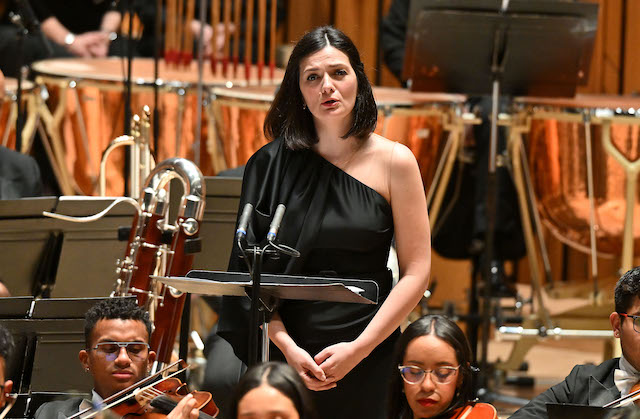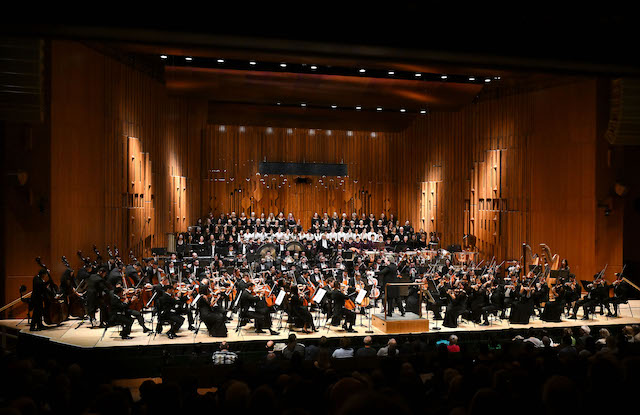Simón Bolívar Symphony Orchestra, Dudamel, Barbican review - an epic journey from gossamer-like intimacy to apocalyptic rage | reviews, news & interviews
Simón Bolívar Symphony Orchestra, Dudamel, Barbican review - an epic journey from gossamer-like intimacy to apocalyptic rage
Simón Bolívar Symphony Orchestra, Dudamel, Barbican review - an epic journey from gossamer-like intimacy to apocalyptic rage
An orchestra on top form in Mahler's Third Symphony despite swirling controversies
Gustavo Dudamel and the Simón Bolívar Symphony Orchestra of Venezuela took the Barbican by storm last night with a thrilling account of Mahler’s Third Symphony, his great exploration of the cosmic order, ascending from raw paganism to sublime transcendence. It's technically the longest symphony ever composed, and here it swept the audience through an epic journey that tilted between passages of gossamer-like intimacy and outbursts of apocalyptic rage.
The orchestra is renowned for its full-blooded performances, yet yesterday evening it felt that the stakes were higher than usual for the ensemble that first captured the imagination of British classical music audiences at the Proms in 2007. In recent weeks the state-funded orchestra has come under attack from fellow Venezuelans – most prominently the pianist Gabriela Montero – for continuing, in effect, to represent President Nicolas Maduro who blatantly stole last year’s election.
This sold-out concert was one of a series marking the 50th year of El Sistema, the world-famous youth music training programme for young, often impoverished, Venezuelans whose lives have been transformed by the orchestra. In the programme, Dudamel – who has also been appointed as the Music and Artistic Director of the New York Philharmonic – wrote a powerful statement in which he declared, “Lately I have been thinking about the relationship between the individual and society – particularly how to balance our personal needs with those of the larger community… The harmony that the orchestra creates has the potential to reach far beyond the stage. I have seen parents who hold completely opposing political views sit next to each other in the audience while their children play together, side by side.”

This symphony depicts Mahler’s vision of the cosmic scale, moving on from the pagan first movement to evoke life forms of increasing complexity. In the second movement, the delicate woodwind opening introduced us to intertwining forms of plant life, with the harps providing streaks of sunlight and skittering strings conveying the chaos of the undergrowth. Mahler was writing the symphony in the year that the Lumière Brothers first screened a film for a paying audience – and as in film there was a sense throughout that we were zooming in and out of the scene before us. Sometimes the orchestral texture was lush and complex, at others – as during the exquisite duet between first violin and harp – it felt like we were being invited to contemplate the structure of one single plant in all its beauty.
In the third movement we encountered the birds and the beasts of the forest in a piece that grows out of Mahler’s earlier Des Knaben Wunderhorn (The Boy’s Magical Horn) – a mischievous piece that asks “Who shall sing to us all summer long” after the cuckoo falls silent. Here the orchestra perfectly caught the teasing tone as the cuckoo and nightingale engage in a singing contest, and the other animals cavort around them. Then, in one of the most beautiful moments of the symphony, we heard Pacho Flores playing the posthorn offstage, filtering through like a call from another dimension. After that we were back to the chaos of the forest, which became steadily more agitated till the movement finished with a joyful shimmer of the harp.
In the fourth movement, mezzo-soprano Marianne Crebassa (pictured above) sang the immortal lines from Friedrich Nietzsche’s Also Sprach Zarathustra – Richard Strauss would compose his own famous setting in the same year that Mahler finished this symphony. This ode to humankind ponders the depths of the pain of existence at the same time as it exalts the redemption of joy. Crebassa’s wonderful expressive voice filled each line to the brim with a contained emotion that was all the more powerful because you could sense the surface tension that stopped it from overflowing. Towards the end of the movement, horns poignantly echoed and amplified her sense of lament.
There was already the sense that this symphony contained enough musical and philosophical ideas for a lifetime, but the sixth movement took us to another level altogether. Following the beatific calm of the opening string passages, the music’s gentle lyricism evoked an all-embracing benevolence that was heightened alternately by the piercing beauty of the woodwind and the sonorous sweetness of the brass. Dudamel perfectly channelled the ebb and swell of the emotions so that the music felt like a balm for the chaos and uncertainty had come before. After the full orchestra came together for the resonant ending, in which Dudamel’s movements powerfully echoed those of the timpani players, the whole audience rose to its feet for a moment that felt like everything to do with freedom and little to do with dictatorship.
Add comment
The future of Arts Journalism
You can stop theartsdesk.com closing!
We urgently need financing to survive. Our fundraising drive has thus far raised £49,000 but we need to reach £100,000 or we will be forced to close. Please contribute here: https://gofund.me/c3f6033d
And if you can forward this information to anyone who might assist, we’d be grateful.

Subscribe to theartsdesk.com
Thank you for continuing to read our work on theartsdesk.com. For unlimited access to every article in its entirety, including our archive of more than 15,000 pieces, we're asking for £5 per month or £40 per year. We feel it's a very good deal, and hope you do too.
To take a subscription now simply click here.
And if you're looking for that extra gift for a friend or family member, why not treat them to a theartsdesk.com gift subscription?
more Classical music
 Classical CDs: Voice flutes, flugelhorns and froth
Baroque sonatas, English orchestral music and an emotionally-charged vocal recital
Classical CDs: Voice flutes, flugelhorns and froth
Baroque sonatas, English orchestral music and an emotionally-charged vocal recital
 Kanneh-Mason, Britten Sinfonia, Shave, Milton Court - a grin and a big beaming smile
A pair of striking contemporary pieces alongside two old favourites
Kanneh-Mason, Britten Sinfonia, Shave, Milton Court - a grin and a big beaming smile
A pair of striking contemporary pieces alongside two old favourites
 theartsdesk at the New Ross Piano Festival - Finghin Collins’ musical rainbow
From revelatory Bach played with astounding maturity by a 22 year old to four-hand jazz
theartsdesk at the New Ross Piano Festival - Finghin Collins’ musical rainbow
From revelatory Bach played with astounding maturity by a 22 year old to four-hand jazz
 First Person: Manchester Camerata's Head of Artistic Planning Clara Marshall Cawley on questioning the status quo
Five days of free events with all sorts of audiences around Manchester starts tomorrow
First Person: Manchester Camerata's Head of Artistic Planning Clara Marshall Cawley on questioning the status quo
Five days of free events with all sorts of audiences around Manchester starts tomorrow
 Goldscheider, Brother Tree Sound, Kings Place review - music of hope from a young composer
Unusual combination of horn, strings and electronics makes for some intriguing listening
Goldscheider, Brother Tree Sound, Kings Place review - music of hope from a young composer
Unusual combination of horn, strings and electronics makes for some intriguing listening
 theartsdesk Q&A: composer Donghoon Shin on his new concerto for pianist Seong-Jin Cho
Classical music makes its debut at London's K-Music Festival
theartsdesk Q&A: composer Donghoon Shin on his new concerto for pianist Seong-Jin Cho
Classical music makes its debut at London's K-Music Festival
 Helleur-Simcock, Hallé, Wong, Bridgewater Hall, Manchester review - moving lyricism in Elgar’s concerto
Season opener brings lyrical beauty, crisp confidence and a proper Romantic wallow
Helleur-Simcock, Hallé, Wong, Bridgewater Hall, Manchester review - moving lyricism in Elgar’s concerto
Season opener brings lyrical beauty, crisp confidence and a proper Romantic wallow
 Kohout, Spence, Braun, Manchester Camerata, Huth, RNCM, Manchester review - joy, insight, imagination and unanimity
Celebration of the past with stars of the future at the Royal Northern College
Kohout, Spence, Braun, Manchester Camerata, Huth, RNCM, Manchester review - joy, insight, imagination and unanimity
Celebration of the past with stars of the future at the Royal Northern College
 Jansen, LSO, Pappano, Barbican review - profound and bracing emotional workouts
Great soloist, conductor and orchestra take Britten and Shostakovich to the edge
Jansen, LSO, Pappano, Barbican review - profound and bracing emotional workouts
Great soloist, conductor and orchestra take Britten and Shostakovich to the edge
 Jakub Hrůša and Friends in Concert, Royal Opera review - fleshcreep in two uneven halves
Bartók kept short, and a sprawling Dvořák choral ballad done as well as it could be
Jakub Hrůša and Friends in Concert, Royal Opera review - fleshcreep in two uneven halves
Bartók kept short, and a sprawling Dvořák choral ballad done as well as it could be
 Hadelich, BBC Philharmonic, Storgårds, Bridgewater Hall, Manchester review - youth, fate and pain
Prokofiev in the hands of a fine violinist has surely never sounded better
Hadelich, BBC Philharmonic, Storgårds, Bridgewater Hall, Manchester review - youth, fate and pain
Prokofiev in the hands of a fine violinist has surely never sounded better

Comments
An extraordinary performance
An extraordinary performance - a privilege to see Dudamel and the orchestra at the top of their game. Thrilling, wondrous stuff.